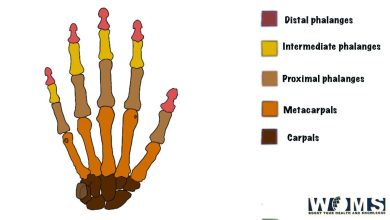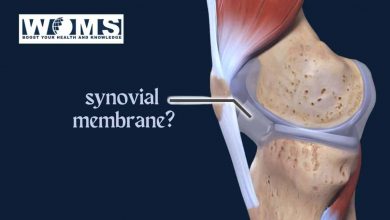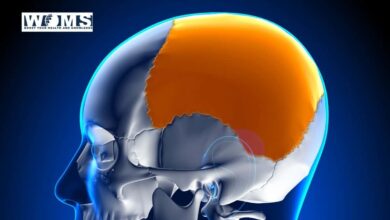Triangle of Auscultation

Triangle of Auscultation: All the things we need to know
The Triangle of auscultation is an important landmark that resembles a small triangular interval. Its boundaries medially are the lateral border of the trapezius muscle, laterally by the medial border of the scapula, and inferiorly by the upper border of the lattisimus dorsi. To know it we must know the triangle of auscultation anatomy.
Auscultation triangle is mainly to auscultate the apex of the lungs. We can hear the respiratory sound clearly here because big muscles do not cover these places.
The 5th and 7th rib, and 6th intercostal space (ICS), and the rhomboid major form the floor of the triangle. The triangle of auscultation is the part of the back where no big muscles cover it. Hearing the respiratory sounds of the apex of the lower lobe through a stethoscope is better when you are listening over this triangle on each side.
In early times when X-rays were not in use, the oesophageal tumors came to notice by hearing the sound of liquids that people were swallowing and auscultating over this triangle to confirm it on the basis of the sound heard. Let’s Know about the triangle of auscultation anatomy.
Boundaries: Triangle of auscultation
The triangle of auscultation boundaries consists of medially, laterally, inferiorly, and floor.
The triangle of auscultation boundaries are :
- Medially: By the Trapezius muscle’s lateral border
- Laterally: By the scapula’s medial border
- Inferiorly: By the lattssisimus dorsi’s upper border
- Floor: By the 5th and 7th rib, and 6th intercostals space, and the rhomboid major.
If you know the triangle of auscultation anatomy and boundaries then you can know the triangle of auscultation very well.
Muscles of Triangle of auscultation:
The muscles present in the triangle of auscultation are :
1. Lattisimus Dorsi
This muscle forms the inferior border of the triangle of auscultation and it is a large muscle.
Origin: The spinous processes of thoracic vertebrae seven though lumbar vertebrae five, the thoracolumbar fascia, the inferior angle of the scapula, the lower ribs, and iliac crest of the sacrum
Insertion: In humerus i.e Floor of the bicipital/intertubercular groove
Action: In adduction, medially rotate, and extend the arm at the glenohumeral joint.
Innervation: By the thoracodorsal nerve which originates from nerve roots C6 to C8.
This muscle is clinically felt by feeling the contracting muscle in the posterior fold of the axilla this is done when the patient is allowed to cough.
2. Trapezius
It forms the superior border of the triangle of auscultation.
Origin: The spinous process of cervical vertebrae seven through thoracic vertebrae 12. It also originates from the protuberance of the occipital bone, ligamentum nuchae, and medial superior nuchal line.
Insertion: The lateral clavicle, the spine of the scapula, and the acromion.
Action: To elevate and superiorly rotate the scapula and extend the neck, to adduct the scapula, to stabilize the scapula even further and assist the upper fibers in rotation of the scapula.
Innervation: Accessory nerve, and the ventral rami of C3 and C4.
The muscle is clinically felt when the patient is allowed to shrug the shoulder against their resistance.
3. Teres Major
It forms the medial border of the triangle of auscultation.
Origin: The inferior angle of scapula and lateral border of the scapula
Insertion: Onto the inter-tubercular groove of the humerus.
Action: Acts to adduct, medially rotate and extend the arm at the glenohumeral joint.
Innervation: By the lower scapular nerve which originates from nerve roots C5 to C7.
4. Infraspinatus
It forms the medial border of the triangle of auscultation.
Origin: From the scapula i.e the infraspinous fossa
Insertion: Onto the greater tubercle of the humerus.
Action: It acts to laterally rotate the joint called the glenohumeral and aids in stabilizing the shoulder.
Innervation: Innervated by the supra-scapular nerve which consists of nerve roots C5 through C6.
Do read: Ball and socket joint
Clinical significance:
For pulmonary auscultation and thoracic procedures triangle of auscultation is very useful. Respiratory sounds are audible more clearly with a stethoscope and it is due to muscle’s nature i.e they are thin and the posterior thoracic wall is closer to the skin surface. The cardiac orifice of the stomach on the left side lies deep to the triangle.
In early times when X-rays were not in use and an oesophageal tumor came into notice by hearing the sound of liquids that people were swallowing and auscultating over this triangle to confirm it. It is covered by scapula. If you want to expose the floor of the triangle then you need to fold your arm across your chest and rotate the scapula laterally and bend forward the trunk which resembles somewhat a fetal position.
It is also in use as a surgical approach path. The rhomboid intercostal nerve block is in use as it can help to relieve pain after rib fractures.
Takeaway:
The Triangle of auscultation is an important landmark. It contains muscles like the trapezius muscle, the scapula, and the lattisimus dorsi. The Triangle of auscultation is mainly to auscultate the apex of the lungs.
We can hear the respiratory sound clearly here because these places are not covered by big muscles. It is also used as a surgical approach path. The rhomboid intercostal nerve block is used as it can help to relieve pain after rib fractures.
FAQS:
1. Which Intercostal space lies in the triangle of auscultation
The sixth intercostal space lies on the floor of the triangle of auscultation.
2. What makes the triangle of auscultation?
The borders of muscles like the trapezius and latissmus dorsi and bone scapula make the triangle of auscultation.
3. What is the importance of the triangle of auscultation?
The importance is that it is the place from where we can hear the heart and the lung’s sound and helps the clinician to diagnosis properly.




